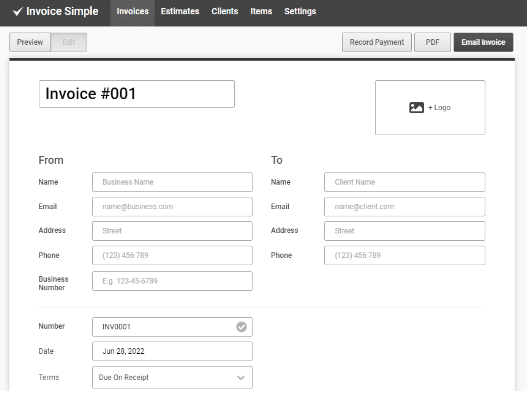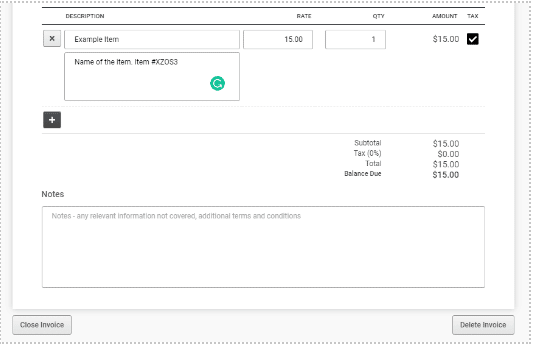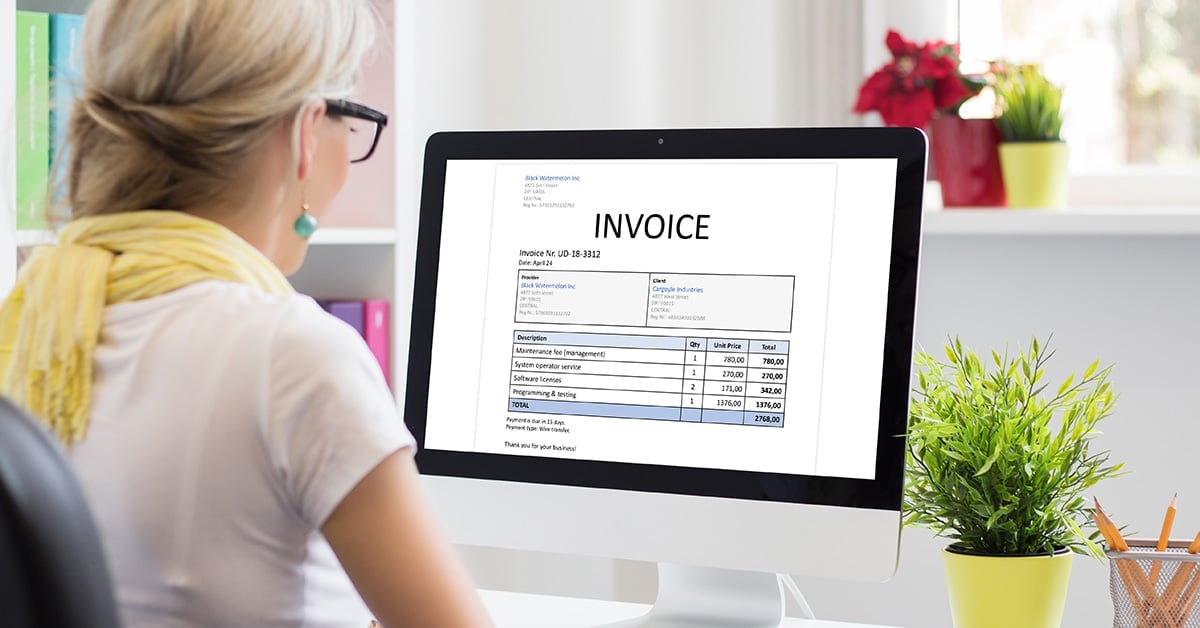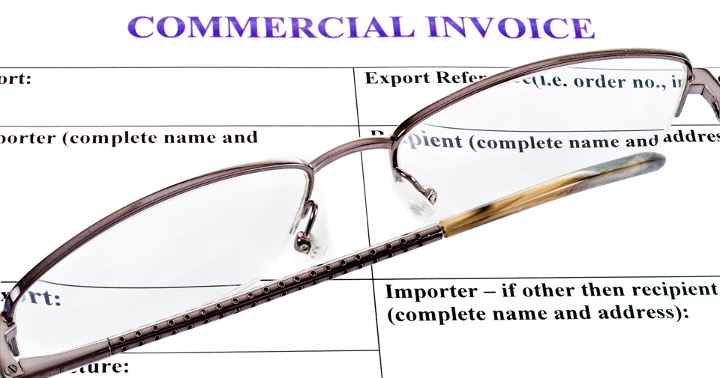What is a Sales Invoice & How to Create One in 5 Steps
June 29, 2022 by Invoice Simple

In the modern business world, independent contractors and freelancers must wear many hats. One of those is handling all the accounting and finances for your business. A critical part of this is creating, sending, and tracking a sales invoice. In this article, we’ll define what a sales invoice is, its most common elements, and tips on how to create and send one.
Sales Invoice Definition
A sales invoice is an accounting document that records a transaction between your business and its clients. They offer you a record of the services you provided or products you sold to your clients, when those services occurred, and how much they owe you. Even if your company is just starting out, it’s important to begin the habit of creating sales invoices for each job. Some use the term interchangeably with other accounting documents like bills, sales receipts, purchase orders, or sales orders. However, they aren’t the same.
Sales Invoice vs. Bill
A sales invoice and bill are similar. What sets them apart is that invoices usually have more information. Invoices are commercial documents that you use for accounting and tax purposes with all the transaction details. Bills are more generic and for immediate payment, like the check at a restaurant.
Sales Invoice vs. Sales Receipt
A sales receipt comes after the sales invoice. It documents the recording of the payment for goods or services. Some of your customers may request this so they have proof of payment for their tax records.
Sales Invoice vs. Purchase Order
A purchase order is what a customer sends to you to verify their order, which could include quantity, item descriptions, delivery dates, and prices. Having a purchase order from a business can also accelerate payment.
Sales Invoice vs. Sales Order
A sales invoice and sales order are accounting documents. The primary difference is how they originate. A customer creates a sales order when purchasing goods or services. A sales invoice is from the business supplying that good or service.
What Is the Purpose of a Sales Invoice?
The purpose of a sales invoice is to submit it to your customers for payment. It’s the official way to request payment for services or products provided. They serve as documentation of a business transaction that you and your customers both need. Additional essential functions include:
- Ensuring accuracy in bookkeeping: The sales invoice creates a record of the sale. When you record these correctly, you have what you need to track your sales, manage cash flow, and create reports on your monthly revenue.
- Providing a reliable resource for your taxes: Sales invoices are vital documents for verifying what you record in your tax returns. The IRS recommends using sales invoices as a supporting business document. This process of recording sales makes it much easier at tax time.
- Acting as a component of inventory management: If you sell physical products, these invoices can be useful for managing inventory. They help you track the inventory going out each month to forecast what you’ll need in the future, so you have plenty of stock.
- Offering legal protection: An invoice can be pivotal in protecting you from unsubstantiated lawsuits a customer may file. They are the proof of service or product delivery along with the dates and costs.
- A source of data for developing a business plan: Sales invoices record lots of data, specifically what volume you’re selling at and what revenue you’re generating. Over time, you can begin to see trends in your sales, such as seasonality, product popularity, average costs, and more. You can use this to better inform your future decisions on growing your business.
Understanding how crucial a sales invoice is, you may be wondering how they work and when to send them.
How a Sales Invoice Works and When to Send Them
The creation of the sales invoice occurs after the product or service delivery. It will convey the transaction details and payment expectations. The exact time you send them depends on when you do your accounting. You can opt to send them immediately after delivery as part of closing out a job. Depending on the volume of sales invoices you create, you might choose to do them all at the end of the month. Those that fall in this category will need a stable cash flow so that you can meet all your payment obligations. Whatever you decide, be consistent. You don’t want an invoice to fall through the cracks and not get sent on time. Now, you’ll want to know all the things that your sales invoice should include, covered in the next section.
What Are the Components of a Sales Invoice?
As noted, a sales invoice has lots of details. You want to include all the following components as long as they apply. By doing so, you can avoid mixing up orders and prevent failed payment attempts. A sales invoice typically includes:
- Today’s date.
- Your business details, including business name, address, phone number, email, and website. If you want the invoice to be more professional, consider adding your logo.
- Client contact information, including the specific person that ordered the service or product, company name, address, email address, and any other necessary information.
- An invoice number: If you’re using accounting software, it will populate this for you. If not, and you’re using a template in Word or Excel, create a numbering system like #001, #002, etc.

This image shows where to include your business details, client contact information, an invoice number, and today’s date—all covered at the top of an Invoice Simple sales invoice.
- Detailed list of services or products provided. Describe the service with specifics. If it’s a product, add its name and item number if you have these. Include the date as well.
- Quantity of the service or products; if service, then the hours worked if you charge by the hour.

This image shows the bottom half of the Invoice Simple sales invoice, where you can list your products, services, the quantity, and the rate you charge. Include any notes about payment terms or any other details you would like customers to see.
- Payment terms, such as due upon receipt or an agreed-upon 15- or 30-day payment cycle and how to remit payment (e.g., credit card, check, cash, payment apps, etc.). Also, describe any late fees charged if payment is late.
- Payment due date based on the payment cycle.
- Total amount owed for services or products and any tax or discounts if applicable. If it’s per piece or hour, show the quantity, unit price, and final amount.
- Purchase order number: If the client provided you a purchase order number prior to delivery, include that so it’s easier for their accounting system to verify the invoice.
Creating an Invoice: Step-by-Step
Follow these steps to create your invoice:
- Determine the platform you’ll use: either a tax accounting software, an estimating and invoicing software, or making your own with a template in Excel or Word.
- Fill in your company information and the customer’s details.
- Enter the descriptions, including services, products, quantities, etc.
- Add the amounts per item or hour or flat fee.
- Conclude with payment terms.
Then it’s ready to send by email or regular mail.
Sales Invoice Tips for Independent Contractors and Freelancers
Now that you know all the basics about what a sales invoice is, it’s time to take in some tips on the process. Here are some guidelines for creating and sending invoices.
- Make sure you have the correct contact information for the buyer by verifying that from the beginning. Any little error could mean a delay in delivery and payment.
- Confirm receipt if emailing: An accounting software will automatically notify you when the person opens the email. If not using a platform, request a read receipt of the email you send.
- Avoid getting stuck in a junk folder: With an accounting app, the from email address won’t be yours, so that means it might not show up in the primary inbox. If you don’t see a send receipt from the software, follow up with your customer to see if that’s where it landed.
- Set due dates that aren’t flexible and that are previously agreed upon: By doing so, you’ve set expectations, and this can ensure on-time payments and consistent cash flow.
- Use clear language in payment terms; otherwise, the remitter may have confusion about how and when to pay you.
- Create reminders within your invoicing software or calendar to check in on payment due dates if not received.
- Offer multiple payment options so it’s easy for your customers. A good practice is two to three payment options.
Creating Sales Invoices: A Must-Have for Freelancers and Contractors
As an independent contractor or freelancer, you no longer get a regular paycheck every two weeks. You’re collecting money based specifically on projects, hours, or products. As such, you’re responsible for getting yourself paid. By understanding the importance of a sales invoice, what it should include, and how to ensure easy payments, you’ll be able to generate reliable income and record all your transactions. Learn what to do about unpaid invoices in our blog, Unpaid Invoices: A Simple Guide For Freelancers & SMEs.












